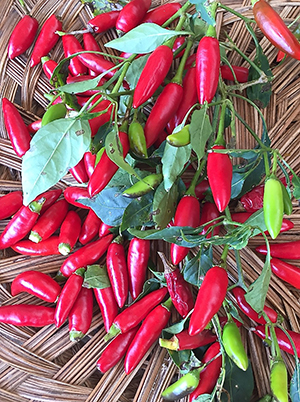Like many foodstuffs whose origins might be obscure to those consuming them, powdered turmeric has an unlikely life, starting as a rhizome, or clumpy root, resembling ginger, and passing through a dramatic seasonal metamorphosis. In any climate cooler than the full-blown tropics it loses its glossy leaves as autumn progresses, and soon disappears from view.
As the weather warms the rhizome shoots of this shade loving plant begin to re-emerge, like caterpillars from their chrysalis, sending up glossy green leaves that by mid-summer will stand more than a metre high and frame beautiful white flowers.
The plant looks so lush that it will never die, and indeed it doesn’t, as the cycle goes on underground, with the rhizomes expanding at an astoundingly rapid rate. While they can be dug up and harvested at any stage, they are best left until early winter when the roots are firm and able to be stored (in my experience, refrigeration spoils them, and ditto for mature edible ginger). Tumeric can be used in curries, blended drinks, adding colour to steamed rice and other recipes.
The roots comes in shades of yellow, like the powder, and orange-red, my preference, and have various health-giving properties, with some apparent value as an anti-oxidant.
In my backyard plot they complement other Asian cookery essentials, including edible, die-down-and-reshoot-next season ginger and its cousins, the greater and lesser galangals, another rhizome plant, which impart a sharp/woody taste to Thai curries. Known as ‘Laos’ in its powdered form, which is far less tasty than the fresh root, galangal is a perennial that provides a year-round tropical look to the garden. The greater form grows to nearly three metres.
Frustratingly, the wonderful coriander, another Asian essential, only thrives locally during the cooler months unless grown in a shade house or hydroponically. In our summers it bolts to seed and has no value.
Better to use the space to grow Thai basil, which is an easily grown, longer lasting than the normal version and a superb addition to any Asian meal. The pungent Vietnamese (or Cambodian) mint is also a garden asset, great for Asian salads when used judiciously.
Curry leaf, plants of which can be sourced locally, becomes a handsome shrub in the right conditions, and is a named ingredient in most Indian and Sri Lankan recipes. Dried leaves are much inferior.
Citrus flavours are another key Asian taste, and the best providers are lemongrass and Kaffir lime leaves and the zest of its knobbly fruits. The former is easy to propagate from stems bought at a local market, even supermarket, or nursery, and make a great border plant, providing useful mulch during the high growth period in summer when they love a good hair-cut. After they die back, dig them up, separate them, trim the roots and replant. The ‘secrets’ to lemongrass are full sun and good drainage.
Kaffir lime trees are fairly fool proof, less problem prone than most citrus, and the unique taste is a must for Thai food and other dishes. It works in baking, too.

While a potential trap for the over-confident diner, the many varieties of chillies, that great import from the ‘New World’ (Latin America) are integral to Asian cuisine. Unlike say, coriander, they have a tendency to die back, or fail completely, in winter, although some can kick on for years with a strong pruning.
Regardless of how hot the variety may be, at least they won’t kill us, unlike their relative in the Solanaceae family, Deadly Nightshade, aka Belladonna.
Chilli ‘peppers’, as they are sometimes misnamed, are also feted for their medicinal and health giving properties, being rich in vitamin C and other goodies, and are said to help with weight control because of their ability to metabolise food intake.
Chillies come in an infinity variety of shapes, sizes, colours and hotness, the last being measured on the Scoville scale, which range from zero (sweet bell peppers) up to call-an-ambulance (Mexican habañeros can rate up to 500,000 units of heat).
Warning: drinking iced water does not help with a chilli overdose, although plain yogurt might, and if you get chillies in your eyes then try doing what the Viet Cong taught me (that’s another story) - find someone with long hair (which I once had) and use that to rub it away.
Whichever chilli variety one chooses to plant, ranging from the tiny bird’s eye, which goes mad throughout summer, to medium-sized fats, the bonnet-shaped or attractive slenders, they all flourish in this area. Eaten fresh, whether red or as unripe greens, preferably chopped up with soy sauce, they are delicious.
Dried and added to cooking, they enhance any dish, from Asian through to Italian pasta sauces. Drying chillies is an easy and rewarding process, best done by spreading them, de-seeded or not, on a flat basket or plate and exposing them to the day’s hot sun for five hours over the course of a week or more. Drying in the oven is risky, unless the temperature is very low, as they burn easily. When dry, whisk them in a food processor and store for future use.
Happy growing, happy cooking and happy eating!
















